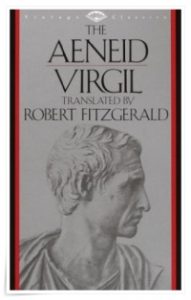![]() How do you teach this work? How integral is it to your curriculum? What should other teachers consider? Rank usage, add content, or share comments below.
How do you teach this work? How integral is it to your curriculum? What should other teachers consider? Rank usage, add content, or share comments below.

Author:
Virgil
Edition:
Robert Fitzgerald, Vintage; Reissue edition (June 16, 1990)
Summary:
The Aeneid is a Latin epic poem, written by Virgil between 29 and 19 BC, that tells the legendary story of Aeneas, a Trojan who travelled to Italy, where he became the ancestor of the Romans. It comprises 9,896 lines in dactylic hexameter. The first six of the poem’s twelve books tell the story of Aeneas’s wanderings from Troy to Italy, and the poem’s second half tells of the Trojans’ ultimately victorious war upon the Latins, under whose name Aeneas and his Trojan followers are destined to be subsumed.
The hero Aeneas was already known to Greco-Roman legend and myth, having been a character in the Iliad. Virgil took the disconnected tales of Aeneas’s wanderings, his vague association with the foundation of Rome and a personage of no fixed characteristics other than a scrupulous pietas, and fashioned this into a compelling founding myth or national epic that at once tied Rome to the legends of Troy, explained the Punic Wars, glorified traditional Roman virtues, and legitimized the Julio-Claudian dynasty as descendants of the founders, heroes, and gods of Rome and Troy.
The Aeneid is widely regarded as Virgil’s masterpiece and one of the greatest works of Latin literature.
– Aeneid. In Wikipedia. Retrieved April 5, 2017, from https://en.wikipedia.org/wiki/Aeneid
What are the key instructional portions of this text? –No content yet. Be the first to contribute!–
Citizen
Fate
State
Virtue & Vice
War & Peace
What should other teachers know about inappropriate content in this text?
Grammar
Logic
Rhetoric
Join the Discussion
In your curriculum, how large of a role does this book play?
1-Reference Only; 2-Brief Readings; 3-Select Chapters; 4-Sections; 5-The Whole Book

